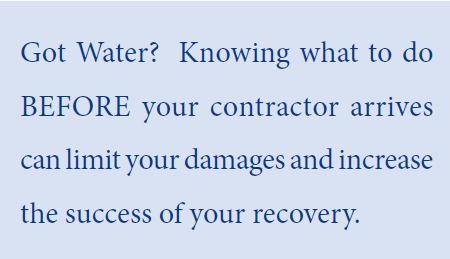 Whether you count your career in months, years or decades…it doesn’t take much time to see this pattern: the overwhelming majority of the property losses you face are liquid based events. Your “Location, Location, Location” will be interrupted by “Water, Water, Water” because it is the most common cause of property loss. The risk is present year round, whether it’s a flood that’s weather driven, or it rains inside your space due to a plumbing break or roof leak. Due to its threat level to life safety, fire receives our attention to protocols by way of building design, code compliance, annual inspections, drills, materials selection and more. However, the rate of incidence of fire is extremely low compared with the frequency, and high cost of property damage and business interruption caused by water. With this in mind, it’s a great return on your investment of time, to initiate or review your team’s plan for response.
Whether you count your career in months, years or decades…it doesn’t take much time to see this pattern: the overwhelming majority of the property losses you face are liquid based events. Your “Location, Location, Location” will be interrupted by “Water, Water, Water” because it is the most common cause of property loss. The risk is present year round, whether it’s a flood that’s weather driven, or it rains inside your space due to a plumbing break or roof leak. Due to its threat level to life safety, fire receives our attention to protocols by way of building design, code compliance, annual inspections, drills, materials selection and more. However, the rate of incidence of fire is extremely low compared with the frequency, and high cost of property damage and business interruption caused by water. With this in mind, it’s a great return on your investment of time, to initiate or review your team’s plan for response.
Download Printable Article (Preventing the Most Common Cause of Property Loss) >>>

HOW READY IS YOUR STAFF TO CONTAIN A WATER LOSS? (the most common cause of property loss)
6 Quick Questions before the next emergency
• Is my staff aware of the Safety hazards of a water event, and how to safely navigate them?
• Is a diverse cross-section of my staff knowledgeable and trained in how to shut off the water?
• Are key 24/7 contacts for subs such as plumbers, electricians, alarm and remediation contractors at your fingertips and in hard copy? Is the information published and posted in a logical, accessible manner?
• Do I have an app with a closed group, or group text pre-loaded for my crisis team and I to communicate during an emergency?
• Is my staff trained in how to divert water in a multi-floor water release, and how to conduct an assessment of the extent of damages?
• Do we have basic tools on hand such as shop vacs for extraction, plastic sheeting to cover and protect contents, and clear bags to remove (but not dispose of) water impacted items?
SAFETY FIRST
• Make certain the area is safe for entry, free of electrical hazards. A licensed electrician is required to manage the following:
• Water impacted basements housing electrical and HVAC
• Equipment and appliances not rated for submersion
• Any wiring, outlets, and panels that have come in contact with water
• Coordinate with a licensed mechanical contractor to inspect and verify HVAC equipment if affected by water damage.
• Contact Alarm & Elevator contractors as needed.
• Determine Category of Water Source (Clean or Contaminated).
• If Flood or Sewage water, PPE and environmental testing are recommended.
ADDRESS THE SOURCE
Address the source and stop water from flowing into the building. Multiple people in various departments should be trained in how to shut off the water. Photomapping and signage to demonstrate the location and instructions for shut off valves is key.
INSPECTION & INITIAL CLEANUP
• A Thorough Assessment is the Foundation of a Successful Recovery. Missed areas and issues create costly secondary damage down the road.
• Direct and/or capture water in a manner that is efficient and prevents further infiltration and damage. For example, when water pouring from floor to floor, direct water into one stream through one deliberate opening in the ceiling tiles, instead of many points.
• Walk the building to determine extent of damage. Use the “360 degrees” approach. Work from the source room/area, up & down, side-to-side, follow gravity as water seeks its lowest point.
• Inspection Tools Include: High powered flashlight, Hygrometer (Temp & Humidity Monitor), Moisture Meter, Thermal Imaging camera, painter’s tape for waterlines & mark out and floor plans.
• Document via photos & video.
• Move sensitive equipment, cover & protect contents.
• Extract standing water, set drying equipment.
• Manipulate contents in a manner to promote proper drying. For example, move lateral cabinets away from walls, roll back carpet and carpet pad.
• Remove saturated contents, do NOT dispose, document, allow insurance adjuster to determine if salvageable. Save potential faulty parts and subcontractor logs in the event subrogration (legal means of seeking other another party’s resources for financial recovery) measures apply.
COMMUNICATION
• Review your Organizations Chain of Command & Procedures for Internal Reporting.
• Make sure your “phone/text tree” and alert systems are ready to activate your response, and to provide notifications to management, staff and occupants.
Tip: A few basic notification templates developed in advance will go a long way towards saving time and stress during a crisis.
For more information about the most common cause of property loss, Contact:

Christine Messina, Vice President
AllRisk Property Damage Experts
TeamAllRisk.com
877.247.5252 24 Hrs
609.634.9960 cell
christine@allriskinc.com
Connect with us!
https://www.linkedin.com/in/christine-messina-b836073


